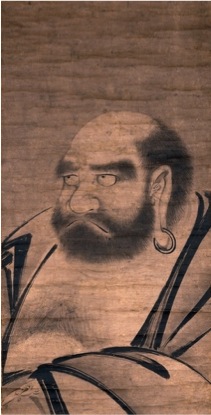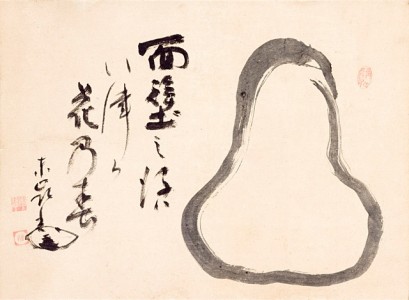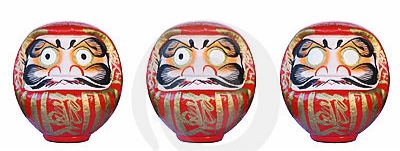Tea and Bodhidharma
The discovery of tea was ever a story of many dimensions, and the telling of the tale depended on the leaf’s use as medicine, food, or drink. Throughout history, tea was intimately related to deities, demi gods, and mortals. In Japan, the monastic use of tea as an aid to meditation was celebrated by linking the plant and its origins to Bodhidharma, the first Patriarch of Zen Buddhism.
Bodhidharma was a Buddhist monk who traveled from India to China around the year 475 of the Common Era. Some thirty five years earlier, he was born a Brahman of the Hindu faith and a prince of the southern Indian kingdom of Pallava. He converted to Buddhism in his youth and was instructed by his teacher to go to China. Arriving by ship on the south China coast, he spent fifteen years traveling to various courts and monasteries, teaching along the way. Sometime around 490, he crossed the river Yangzi and headed north to the capital of Luoyang where he lived until his death in 528.
 Bodhidharma came to China an itinerant, single-minded, and uncompromising individual who wore but a simple robe and carried a begging bowl to observe his vow of poverty. He taught that enlightenment was attained through meditation and equated meditation with realizing one’s true nature. Indeed, his name Bodhidharma meant “one who awakens and understands” and “cultivates the principles of reality.” He adhered to a routine of harsh self discipline and extreme asceticism, rigorous practices that he transmitted to his followers.
Bodhidharma came to China an itinerant, single-minded, and uncompromising individual who wore but a simple robe and carried a begging bowl to observe his vow of poverty. He taught that enlightenment was attained through meditation and equated meditation with realizing one’s true nature. Indeed, his name Bodhidharma meant “one who awakens and understands” and “cultivates the principles of reality.” He adhered to a routine of harsh self discipline and extreme asceticism, rigorous practices that he transmitted to his followers.
Although he spent over five decades in China, Bodhidharma left no account of his activities there. Instead, legends and high tales swirled about him, placing the master in the middle of the religious strife and controversy of the time. He was portrayed as an uncouth and unattractive character. Invited by emperors to expound on Buddhist doctrine and practice, his rough appearance and blunt manner offended potential patrons. Monosyllabic and miserly with his words, he was inured to pleas from admirers for instruction until they somehow proved themselves. Only then did he take them as disciples, and in one awful instance, he took their very flesh and bone. It was said that he met threats of violence with his own form of martial arts and eluded plots of poisoning and assassination by secreting himself in caves outside the capital.
 Physically and mentally tough, Bodhidharma’s posthumous portraits revealed him as coarse featured, hirsute, and typically brooding or scowling. His curt and unsparing manner alienated him from the wealth and prestige accorded clerics of a more facile and accommodating mien. He never had the ear of an emperor; no great prince ever built him a temple or monastery. He wandered around the region of Luoyang, visiting the capital’s political and cultural spheres but skirting the bright bubbles of power and wealth that attracted and trapped fat abbots and sleek priests. He did, however, impose upon his Buddhist brethren, taking their charity, staying at their monasteries, sleeping in their bare halls, and eating their monkish meals. But the alms and courtesies he received were grudgingly given for even among Buddhists Bodhidharma was an eccentric who lived a reclusive and solitary existence.
Physically and mentally tough, Bodhidharma’s posthumous portraits revealed him as coarse featured, hirsute, and typically brooding or scowling. His curt and unsparing manner alienated him from the wealth and prestige accorded clerics of a more facile and accommodating mien. He never had the ear of an emperor; no great prince ever built him a temple or monastery. He wandered around the region of Luoyang, visiting the capital’s political and cultural spheres but skirting the bright bubbles of power and wealth that attracted and trapped fat abbots and sleek priests. He did, however, impose upon his Buddhist brethren, taking their charity, staying at their monasteries, sleeping in their bare halls, and eating their monkish meals. But the alms and courtesies he received were grudgingly given for even among Buddhists Bodhidharma was an eccentric who lived a reclusive and solitary existence.
He cut an odd figure about Luoyang, walking along the crowded streets in search of the great monasteries and their dazzling temple halls and images. In the sixth century, Luoyang was one of the greatest cosmopolitan cities in the world, the glorious seat of a court that lavished patronage on the Buddhist establishment. The Yongning Pagoda was the greatest monument in the capital. Built in 516 by the dowager empress to honor her parents, the pagoda soared high above the city:
“In the middle of the monastery grounds was a nine-storied, wood pagoda, nine hundred feet high with a hundred-foot mast, rising a total of one thousand feet from the ground…At the top of the mast was a precious vessel with a capacity of twenty-five piculs of grain, and below it were arrayed thirty plates of gold to catch the morning dew, each hung about with gold bells. From the mast to the four corners of the pagoda were iron chains hung with gold bells the size of sacks of grain. The corner eaves of each of the nine stories were decorated with gold bells, from top to bottom, one hundred twenty in all…In the high winds of very deep nights, the harmonious ringing of the precious bells were heard over three miles away.”
When Bodhidharma saw the pagoda and its “gold discs reflecting the sunlight into the clouds and the wind sending the peals of its precious bells into the heavens,” he turned strangely loquacious and “chanted praises of this truly divine work, saying, ‘in my one hundred fifty years, I have traveled many countries, but there is no temple of this beauty in Jambudvīpa nor in any of the lands of Buddha.’ Chanting nanwu, he held his hands together for days on end.”

Among the tales about Bodhidharma was a rather gruesome but darkly entertaining episode at the Shaolin Temple, where it was said that he meditated for many years in a nearby cave. As he sat immobile for hours and days at a time and for years on end, Bodhidharma gradually began to lose body parts. At length, he lost his legs, which withered away, and then his arms quickly followed. In later Zen painting, he was often depicted as seated, a blank, cowled figure, a mere amoebic outline in ink, featureless and nearly formless, a shade in reverse. Then, Bodhidharma even lost his shadow. After a marathon of meditation, he moved to get up but his shadow did not. It sat fixed to the wall – a grim silhouette seated in stern rebuke – a silent admonition to return to contemplation.
While gradually losing himself in his cave, surrendering his body and ego to his spiritual quest, Bodhidharma drank tea. Tea was long used in Chinese monasteries as an aid to meditation for it stemmed hunger, cleared the mind, and sharpened resolve. Bodhidharma was introduced to tea in China, and he incorporated tea into his meditation regimen, passing the practice along to his disciples.
The legend of tea and Bodhidharma was particular to Japan where for centuries both plant and Zen Patriarch were revered as cultural icons. Bodhidharma, known as Daruma in Japan, was acknowledged by Japanese custom as the progenitor of not only Zen Buddhism and but also of tea. As the sect that relied most on meditation for enlightenment, Zen Buddhists were closely associated with tea, and Bodhidharma was the leaf’s foremost proponent. In the popular imagination, the Patriarch, the plant, and meditation were melded into a miracle tale of utter fury and bloody retribution.
As with all things concerning Bodhidharma, the genesis of tea was neither simple nor easy but rather a singularly peculiar but characteristically gory event that was in keeping with the high physical price of his ruthless meditation – a cost that the master seemed always to pay with an arm and a leg. On this occasion, the birth of tea took a more delicate part of his anatomy. As he sat in deep concentration, Bodhidharma abruptly realized that in an agonizing instant of fatigue, he had closed his eyes and dozed off to sleep. In anger at his weakness, he savagely tore at his eyes in self disgust, ripping out his eyelids and flinging them to the ground. As the leaf like lids of flesh lay bloody in the dirt, they sprouted miraculously into tea plants. Instinctively, Bodhidharma reached over and plucked a few leaves from the bushes to chew and suddenly felt as “one who awakens.” His mind clear and focused, he resumed his meditation.
The legend of Bodhidharma wasting away gave force to the popular representation of the master as the Daruma Doll. Armless and legless, hollow and weighted, the roly-poly toy always remained balanced and upright even when tipped. Decorated in bright red, the eyes of the doll were lidless and without pupils. Acquired at the New Year, resolutions were made by painting in the right eye. When at last the goal was met and the promise kept, the left eye was filled to celebrate the success. At the end of the year, the old doll is ceremoniously burned and a new one obtained. Year after year, the Daruma Doll commemorates the sacrifice and discovery of an Indian master in China so very long ago, a playful remembrance of Bodhidharma’s enlightenment and teachings, and the profound Zen legend of the marvelous origins of tea.
Sources
Biography
The Zen Teaching of Bodhidharma, Red Pine (Bill Porter), trans. (New York: North Point Press, 1987), pp. ix-xvii; cf. Heinrich Dumoulin, Zen Buddhism: A History, James W. Heisig and Paul Knitter, trans. (New York: Macmillan Publishing Company, 1988), vol. 1, pp. 86-89.
Yongning Pagoda
Yang Xüanzhi 楊衒之, Luoyang qielan ji gouchen 洛陽伽 藍記鉤沉 (Anecdotes from the Record of Buddhist Monasteries of Luoyang, 547 A.D.) (Taipei: Guangwen shujü, 1969), p. 22. Corrected and emended, the translation follows William John Francis Jenner, Memories of Loyang: Yang Hsüan-chih and the Lost Capital (493-534) (Oxford: Claredon Press, 1981), p. 151.
Figures
Artist unknown
Red Robed Bodhidharma, ca. 1260 A.D
(Daruma zenza zō 達摩禪坐, Bodhidharma Sitting in Meditation)
Japan: Kamakura period
Hanging scroll: ink and color on silk
Inscribed by Lánxī Dàolóng 蘭溪道隆 (1213–1278 A.D)
Kōgakuji Temple 向嶽寺
Yamanashi Prefecture
Japan
Artist unknown
Daruma 達摩 (Bodhidharma), late16th century A.D.
Japan: Muromachi period
Hanging scroll: ink on paper
British Museum
Torei Enji 東嶺円慈 (1721-1792 A.D.)
Meditating Daruma, 18th century
Japan: Edo period
Hanging scroll: ink on paper
Los Angeles County Museum of Art
Daruma Dolls
Paper mache and ink and color

